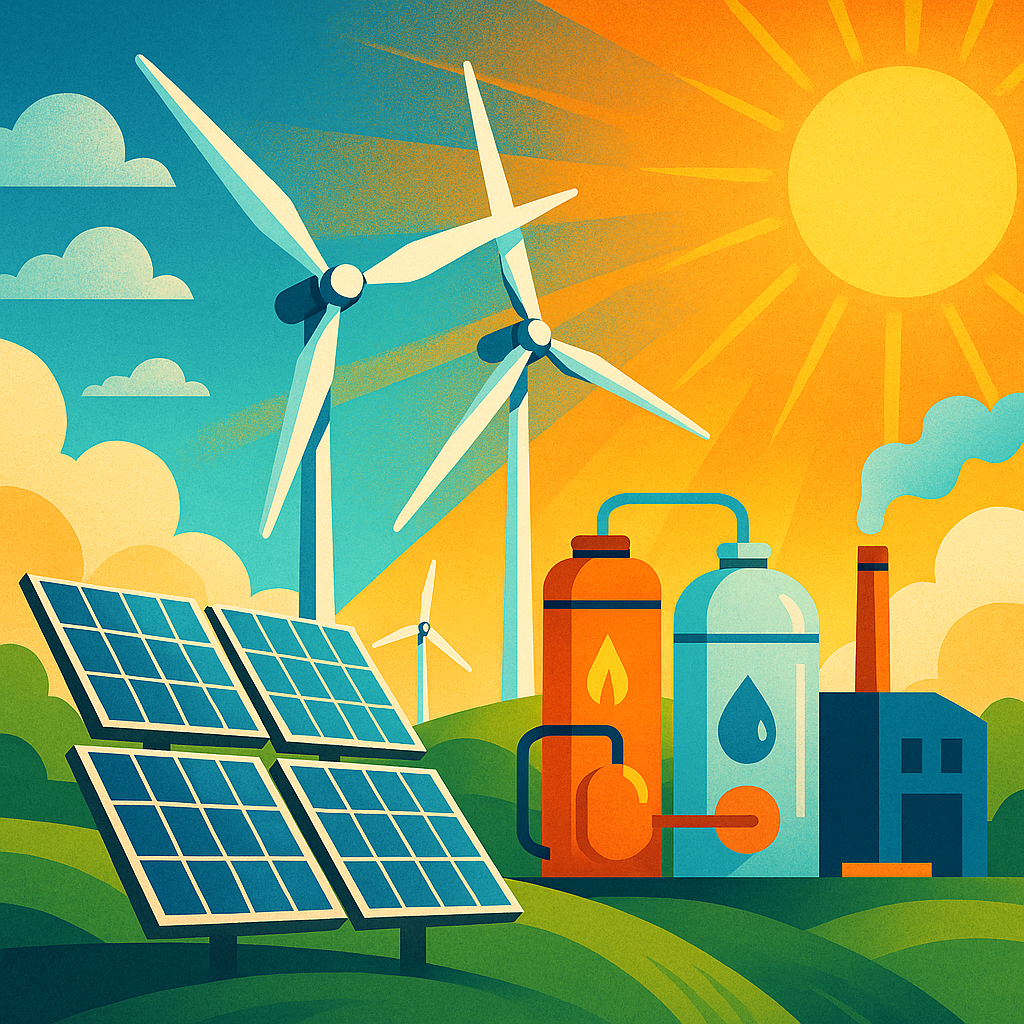The world is undergoing a monumental shift in how it generates and consumes energy. In 2025, renewable energy trends are at the forefront of this transformation, driven by innovation, policy, and the urgent need to combat climate change. With countries investing in sustainable infrastructure and technology reaching new heights, renewables are no longer an alternative—they are becoming the norm. This article explores the top trends and emerging technologies defining the energy landscape in 2025.

1. Green Hydrogen: The Future of Clean Fuel
Among the most promising renewable energy trends in 2025, green hydrogen is capturing global attention. This clean-burning fuel is produced through electrolysis powered by renewable sources like solar or wind. Its versatility makes it suitable for industrial use, power generation, and long-distance transport.
In Northern Tasmania, the Bell Bay Powerfuels project exemplifies this trend. Backed by a $2 billion investment, the facility aims to produce 300,000 tonnes of green methanol annually using a 240MW electrolysis plant powered entirely by renewables (Herald Sun, 2025).
India is also scaling up its green hydrogen capabilities. With support from the National Green Hydrogen Mission, India plans to produce five million metric tonnes of green hydrogen per year by 2030 (The Economic Times, 2025). These developments signal a serious commitment to replacing fossil fuels in sectors that were previously hard to decarbonize.
2. Next-Gen Solar: Perovskite and Floating Panels
Solar power remains a cornerstone of clean energy, but the renewable energy trends in 2025 are all about innovation. Perovskite solar cells are a major breakthrough, boasting efficiencies over 25%. When layered with silicon, these tandem cells can outperform traditional panels significantly (RatedPower, 2025).
Another emerging solution is floating solar farms. These installations save valuable land space and benefit from natural water cooling, which enhances their efficiency. Countries like China and India are already deploying large-scale floating arrays on reservoirs and lakes, demonstrating that this trend is both practical and scalable (Wikipedia, 2025).
3. Breakthroughs in Energy Storage
One of the biggest challenges for renewable energy is its intermittency—solar and wind aren’t always available when demand peaks. This is where advanced storage technologies come in.
Solid-state batteries, flow batteries, and sodium-ion alternatives are becoming more viable. For example, sodium-ion batteries are safer, cheaper, and more sustainable than lithium-ion counterparts, making them attractive for utility-scale applications (RatedPower, 2025). These innovations are essential to achieving 24/7 renewable energy supply.
4. The AI-Energy Nexus
Artificial intelligence is both a driver and a consumer of energy. With AI becoming more prevalent, especially in data centers and edge computing, the demand for clean power is rising.
Companies are now mandating that their AI-driven operations run on renewable sources. This demand is pushing utilities to adopt more wind and solar, particularly in tech hubs like California and Bangalore. The AI-energy relationship is catalyzing a cleaner, smarter grid worldwide (World Economic Forum, 2025).
5. Record-Breaking Global Adoption
2025 is shaping up to be a historic year for renewable energy adoption. India, for instance, added 30 gigawatts of clean energy capacity in the fiscal year ending April 2025. The majority came from solar and wind, which are now cheaper than new coal plants in many regions (AP News, 2025).
In the U.S., corporate procurement reached new heights, with 28 gigawatts of renewable contracts signed in 2024 alone—a 34% increase from 2022. This surge is driven by ESG mandates and the Inflation Reduction Act’s incentives (Business Council for Sustainable Energy, 2025).
6. Rise of Decentralized Power
Decentralized or distributed energy systems are another major theme among renewable energy trends in 2025. Rooftop solar, small wind turbines, and local battery storage allow communities to generate and control their own power.
Microgrids are becoming popular in remote and disaster-prone areas. These systems can disconnect from the main grid and operate autonomously during outages. Advances in peer-to-peer energy trading and blockchain technology are further empowering individuals to sell excess power back to the grid (RenewableWorks, 2025).
7. Industrial Decarbonization Gets Serious
Heavy industries such as cement, steel, and aluminum are notorious for high emissions. However, 2025 marks a turning point. Hydrogen-based technologies are replacing carbon-intensive processes. For example, steel manufacturers are piloting hydrogen-based Direct Reduced Iron (DRI) methods that eliminate coal usage.
Mining giant Rio Tinto is investing heavily in renewables to power its operations. A recent $600 million deal will supply solar power and battery storage to its Gladstone aluminum operations in Australia (The Guardian, 2025; Reuters, 2025). These changes are not just environmental—they’re becoming economically viable as carbon costs rise.
8. Africa’s Renewable Energy Boom
Africa is often seen as an underdog in global energy discussions, but that’s changing fast. With vast solar and wind resources, the continent is well-positioned to lead in clean energy.
Initiatives like the Accelerated Partnership for Renewables in Africa (APRA) aim to increase capacity from 56 GW in 2022 to 300 GW by 2030. Countries like Kenya, South Africa, and Egypt are making significant investments in both generation and grid infrastructure (Wikipedia, 2025).
This growth is critical not just for climate goals but also for expanding access to electricity—still a major issue in parts of Sub-Saharan Africa.
9. Electrification of Transport
Electric vehicles (EVs) are surging worldwide, and they’re intrinsically linked to the rise of renewables. Governments are rolling out stricter emissions regulations and offering generous subsidies for EVs and charging infrastructure.
In 2025, Europe is expected to hit 50% EV market share, while China leads in battery production. Grid operators are now incorporating Vehicle-to-Grid (V2G) technologies, allowing EVs to serve as mobile batteries that support local energy systems.
10. Policy and Private Sector Synergy
Finally, the convergence of policy and private sector action is one of the most influential renewable energy trends in 2025. From carbon pricing to tax incentives, policy tools are being aligned to accelerate the clean energy transition.
Tech companies like Google and Amazon are investing billions in renewables. Governments are pushing for net-zero buildings and phasing out internal combustion engines. The result? A comprehensive, multi-stakeholder effort that is transforming how energy is produced and consumed on a planetary scale.
Conclusion
The renewable energy trends in 2025 represent a pivotal shift in the global energy paradigm. From green hydrogen and floating solar panels to AI-driven efficiency and African leadership, the energy landscape is being redefined by innovation and necessity.
As governments, businesses, and communities embrace these changes, the path to a sustainable, resilient energy future becomes clearer. The time to act is now—because the future is not just renewable, it’s already arriving.
References
- Herald Sun (2025) Bell Bay Powerfuels project to open in Northern Tasmania by 2028. Available at: https://www.heraldsun.com.au/ (Accessed: 1 June 2025).
- The Economic Times (2025) India’s Green Hydrogen Mission. Available at: https://economictimes.indiatimes.com/ (Accessed: 1 June 2025).
- RatedPower (2025) Solar Power Technology Innovations. Available at: https://ratedpower.com/blog/solar-power-technology/ (Accessed: 1 June 2025).
- Wikipedia (2025) Floating Solar. Available at: https://en.wikipedia.org/wiki/Floating_solar (Accessed: 1 June 2025).
- World Economic Forum (2025) 4 Key Trends in Clean Energy Technology. Available at: https://www.weforum.org/ (Accessed: 1 June 2025).
- AP News (2025) India’s Clean Energy Milestones. Available at: https://apnews.com/ (Accessed: 1 June 2025).
- Business Council for Sustainable Energy (2025) 2025 Factbook Key Trends. Available at: https://bcse.org/ (Accessed: 1 June 2025).
- RenewableWorks (2025) Renewable Trends to Watch. Available at: https://www.renewableworks.com/ (Accessed: 1 June 2025).
- Reuters (2025) Steel Decarbonization Technologies. Available at: https://www.reuters.com/ (Accessed: 1 June 2025).
- The Guardian (2025) Rio Tinto’s Renewable Energy Projects. Available at: https://www.theguardian.com/ (Accessed: 1 June 2025).
- Wikipedia (2025) Renewable Energy in Africa. Available at: https://en.wikipedia.org/wiki/Renewable_energy_in_Africa (Accessed: 1 June 2025).






